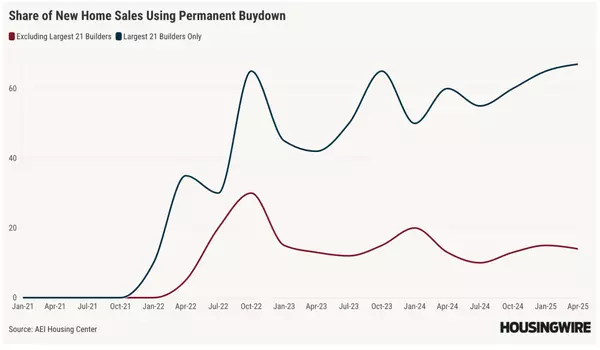Bayview closes acquisition of Guild, taking lender private

Bayview Asset Management has closed its acquisition of Guild Holdings Company, the parent of Guild Mortgage, in a deal that takes the lender private and removes it from the New York Stock Exchange. The transaction was finalized on November 28, according to a new 8-K filing. Under the agreement, shar
Read MoreMaking the 7-day refi reality: Modernizing mortgage appraisals

For many borrowers, the appraisal is the most stressful step in a refinance: part mystery, part high-stakes hurdle. Will the home appraise high enough? Will it delay closing? What actually determines the final value? Lenders can help ease these concerns by adopting the right combination of technolog
Read More-

For the past decade, rate marketing has been the dominant gravitational force in mortgage acquisition. Whoever shouted the lowest 30-year fixed rate the loudest won the most attention. But attention has never been the same as intent, and intent has never been the same as a closed loan. What’s happen
Read More What real estate can learn from LEGO’s reinvention

Just in time for the holidays, Troy Palmquist looks at how this legacy manufacturer bounced back from a market downturn and how agents can, too A few weeks ago, on a podcast, I was asked which brands I admire most. Without hesitation, I said LEGO. The toy company has an incredible comeback story, fr
Read MoreLubbock inventory climbs to 8.1 months, marking Texas’s deepest buyer market

The Lubbock metro housing market has emerged as Texas’s deepest buyer’s market, with inventory levels reaching 8.1 months of supply as of Nov. 22, 2025. This marks a stark departure from the state’s overall 3.6 months of inventory, positioning the West Texas metro as an outlier in an otherwise balan
Read MoreToledo housing inventory jumps 46% as Midwest markets recalibrate

Toledo’s single-family home inventory surged to 1,150 active listings for the week ending Nov. 22, 2025, marking a 46% increase from 787 homes a year earlier. The dramatic inventory expansion coincides with widespread price adjustments, as 38.3% of active listings reduced their asking prices during
Read MoreAre mortgage buydowns a lifeline or a risk for new homebuyers?

The debate over the large builders’ elevated use of mortgage buydowns — and the potential risks to buyers — isn’t new. Reigniting the argument, a recent report from the American Enterprise Institute (AEI) asserts that mortgage buydowns among the large builders are artificially inflating new home pri
Read MorePine Bluff’s low prices are not speeding up home sales

Pine Bluff’s housing market reveals a stark disconnect between affordability and buyer interest, with 34.4% of active listings taking price cuts while homes sit on the market for a median 91 days. The metro’s $139,950 median list price represents less than half Arkansas’s $315,000 statewide figure,
Read MoreConnecticut governor signs bill to tackle affordable housing shortage

Connecticut Gov. Ned Lamont (D) on Wednesday signed a housing bill aimed at addressing the state’s shortage of affordable housing. H.B. 5002, a “much-debated” bill, according to CT Insider, passed during a special session in early November. The bill is a compromise from the version that Lamont had v
Read MoreHigh-end metros see price drops, longer selling times
Pricier metropolitan areas are posting a noticeable slowdown as high-end homes take longer to sell. The top 10% of metro markets — those with median prices above $666,464 — recorded a 2.5% year-over-year price decline in October, HousingWire Data shows. Average home prices in these metros fell from
Read MoreCenter for American Progress offers blueprint to reduce housing costs

The Center for American Progress (CAP) recently put out a plan aimed at lowering housing costs nationwide by increasing construction and making homebuilding more affordable through federal efforts. The “Build, Baby, Build” proposal, published by CAP on Nov. 17, targets the nation’s estimated housing
Read MoreNote to self: sell the lifestyle, not just the house, to boost sales

Selling houses in an uncertain market, as we find ourselves in today, is challenging. Maybe we should stop trying to sell the house and instead focus on the positive impact it will have on our buyers’ lives. This is the approach Mars Inc. used to sell its Snickers bar. The ad campaign “You’re not yo
Read MoreVoters reject housing reform in Colorado suburbs and resorts

Trying to improve housing affordability and ease the path of development faces many hurdles that don’t always involve lawmakers. Voters can make or break efforts through ballot measures and referendums. Colorado’s small towns and Denver suburbs have become test cases in how far “not-in-my-backyard”
Read MoreJason Mitchell Group surpasses 1,300 agents, 36% increase in agent count

The nation’s top-ranked mega team, the Jason Mitchell Group (JMG) has surpassed 1,300 agents, according to an announcement last Wednesday. This represents a 36% increase in agent count over the past year. The team attributed this growth to the firm’s business-to-business referral opportunities, whic
Read MoreHillwood backs new homebuilding fund as AD&C credit tightens

The one thing that’s unambiguous right now in residential development and new construction is that the $80-to-$100 billion homebuilders throughout the U.S. draw on to site and build the new homes they plan to sell in 2026 and each year beyond is harder to get and more expensive to finance. National
Read MoreFirstClose names Adam Nicholson director of professional services

FirstClose, a fintech provider of data and workflow technology for mortgage and home equity lenders, announced on Tuesday that it has appointed Adam Nicholson as director of professional services. Nicholson, who has spent more than a decade leading implementation and professional service teams in th
Read MoreKevin Hassett is the rumored lead for Fed chair position

Kevin Hassett, director of the White House National Economic Council, is the leading candidate to be the next Federal Reserve chair, advisers and allies of President Donald Trump told Bloomberg, as the deadline for a new Fed governor approaches. Trump has voiced his opposition to the current Fed lea
Read MoreNew home price premium hits record low

Monthly payments for new and existing homes are now nearly equal, amid a trend of stagnating prices and increased use of mortgage buydowns among builders. That was one of the main findings from Realtor.com’s Q3 New Construction Report. According to the report, buyers purchasing a new home last quar
Read MoreFormer local Realtor association CEO charged with grand theft

Former East Polk County Association of Realtors (EPCAR) CEO Jennifer Garula-Mers has been charged with grand theft after she allegedly stole over $81,000 from the trade association, leaving it “all but broke,” according to the Polk County Sheriff’s Office (PCSO). The Florida-based Realtor associatio
Read MoreLocal governments turn to AI to streamline housing development

As local governments face mounting pressure to streamline the review process for residential projects, a wave of AI-driven reforms is revealing how modern tools can shave days or weeks off approvals, potentially speeding up housing development. For 15-plus years, pressure has been growing on a shrin
Read More
Categories
Recent Posts










